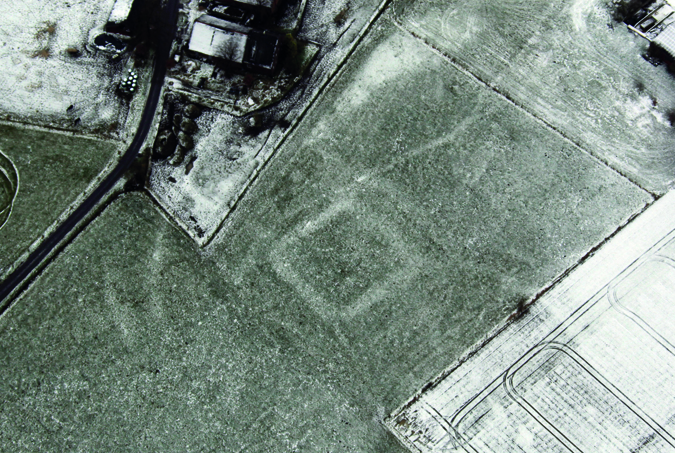Aerial Archaeology
Since the 1990s the Institute of Archaeological Studies has provided a laboratory for aerial archaeology, which is equipped with extensive tools of modern technology. The laboratory research and educational capabilities are available in many areas.
Fig. 1: Circular enclosure in a maize field, taken 28th August 2012
© Aerial image: B. Song
Archaeological interpretation of aerial images
Primarily the laboratory for aerial archaeology deals with the archaeological interpretation of aerial images which have not been taken for archaeological purposes. Generally, it concerns itself with the following aspects: the research of existing external images, the purchase of ideal archaeological images, the archiving of acquired images and the archaeological interpretation of such.In aerial archaeology a various number of sources of information are exploited. They include the archives of military reconnaissance, geological and geographical remote sensing, land surveying, etc. Through the use of aerial image catalogues and indicators within aerial images – depending on the objectives – certain images may be selected and viewed. Among others, the criteria for image selection include image types (vertical or angled images, image overlapping, etc.), image scale and recording time (time of year and time of day). The selected aerial images are obtained either by loan or purchase. Later, these images are archived and prepared for interpretation. Depending on the aim and individual requirements the actual interpretation can be divided into different working phases, such as the preliminary interpretation, interpretation, and the verification by fieldwork. The archaeological contents of aerial images are recognized, interpreted and depending on the aim, documented in a variety of ways (preferably notationally and cartographically).
Archaeological Aerophotogrammetry
At the Institute of Archaeological Studies the Aerophotogrammetry occurs digitally. Both mapping photographs (purpose is for survey of vertical aerial images) and aerial images of the airborne prospection (usually angled images) can be rectified or alternatively georeferenced. The main reason for the geometric image rectification is to correct the lens distortion which occurs due to the central projection of the aerial images. After the graphic rectification, aerial images with certain map properties can be created. Therefore, these aerial images can be further compared to aerial maps with less effort. Furthermore, aerial images can be projected into a geographic coordinate system or into a coordinate system of the national survey (georeferenced). This can serve as the basis for an archaeological information system.
Fig. 2: Alpen-Drupt: Roman military encampment visible as crop marks, taken 18th June 2013.
© Aerial image: B. Song
Aerial Archaeology
The versatility of aerial archaeology allows the recording and exploration of archaeological sites that would usually only be discovered by accident or could only be surveyed with great effort.Aerial archaeology is a method of discovery, observation and documentation for archaeological sites. While archaeological aerial image interpretation is mainly used for field surveys of above ground preserved sites, it also can be used on completely levelled terrain to find preserved underground sites. Aerial survey is the direct flyover of important archaeological areas. Usually a two- or four-seated sporting aircraft like a Cessna 150 or Cessna 172 is used. If a new site is discovered it will be charted and subsequently geolocated via a digital camera GPS. The combination of a small aircraft with an easy to operate camera system allows for the observation and documentation of the sites through different perspectives and flight levels at any time of the year. Through that process it is possible to document and investigate archaeological sites which are usually discovered by accident.
Archaeological Cartography
Sites with different archaeological features can be recorded cartographically in the form of grid-based digital aerial maps and vector-based line drawn maps. This option is important for regions and countries in which topographical maps are either missing or unavailable. At the Institute numerous aerial maps with different scales and an atlas based on the archaeological information system was created.
Fig. 3: Schermbeck-Damm, double-trenches of a motte-and-bailey castle visible as positive snow marks, taken on 14th December 2012.
© Aerial image: B. Song
